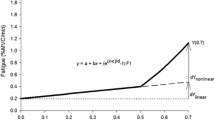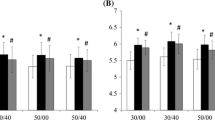Abstract
Body tilt angle affects the fatigue of human calf muscle at a high contractile force (i.e. 70 %MVC); but the range of forces across which this effect occurs is not known and we sought to determine this in the present study. Fourteen men performed intermittent calf muscle contractions at either 30, 40, 50 and 60 %MVC (Group 1 n = 7) or at 80 and 90 %MVC (Group 2 n = 7). Two tests were performed at each intensity in the supine (tilt angle = 0°) and inclined head-up position (tilt angle = 67°). MVC was measured prior to and during each calf exercise test, and the linear rate of decline in MVC during each test was used to estimate muscle fatigue. MVC prior to each test was unaffected by body tilt angle in Groups 1 and 2. In Group 1 muscle fatigue was significantly lower in the inclined than supine position at 50 %MVC (0.10 ± 0.05 vs. 0.19 ± 0.10 N s−1) and 60 %MVC (0.22 ± 0.20 vs. 0.36 ± 0.33 N s−1); but there was no significant difference in fatigue at 30 %MVC (0.07 ± 0.06 vs. 0.07 ± 0.07 N s−1) and 40 %MVC (0.12 ± 0.07 vs. 0.18 ± 0.08 N s−1). In Group 2, muscle fatigue was significantly lower in the inclined compared with the supine position at 80 %MVC (0.90 ± 0.50 vs. 1.49 ± 0.87 N s−1) and 90 %MVC (1.19 ± 0.47 vs. 1.79 ± 0.78 N s−1). These data demonstrate that the postural effect on calf muscle fatigue during intermittent contractions is manifest at moderate to very high forces, but that it does not occur at low forces.




Similar content being viewed by others
References
Barclay JK (1986) A delivery-independent blood flow effect on skeletal muscle fatigue. J Appl Physiol 61:1084–1090
Clarys JP, Marfell-Jones M J (1986) Anthropometric prediction of component tissue masses in the minor limb segments of the human body. Hum Biol 58:761–769
Egaña M, Green S (2005) Effect of body tilt angle on calf muscle performance and blood flow in humans. J Appl Physiol 98:2249–2258
Egaña M, Green S ,Garrigan E, Warmington S (2006) Effect of posture on high-intensity constant-load cycling performance in men and women. Eur J Appl Physiol 96:1–9
Fitzpatrick R, Taylor JL, McCloskey DI (1996) Effects of arterial perfusion pressure on force production in working human hand muscles. J Physiol 495(3):885–891
Gandevia SC (2001) Spinal and supraspinal factors in human muscle fatigue. Physiol Rev 81:1725–1789
Garnett RAF, O’Donovan MJ ,Stephens JA, Taylor A (1978) Motor unit organisation of human medial gastrocnemius. J Physiol 287:33–43
Grassi B (2001) Regulation of oxygen consumption at exercise onset: is it really controversial? Exerc Sport Sci Rev 29:134–138
Hobbs SF, McCloskey DI (1987) Effects of blood pressure on force production in cat and human muscle. J Appl Physiol 63:834–839
Hogan MC ,Richardson RS, Kurdak SS (1994) Initial fall in skeletal muscle force development during ischemia is related to oxygen availability. J Appl Physiol 77:2380–2384
Koga S, Shiojiri T, Shibasaki M, Kondo N, Fukuba Y, Barstow TJ, (1999) Kinetics of oxygen uptake during supine and upright heavy exercise. J Appl Physiol 87:253–260
MacDonald MJ, Shoemaker JK, Tschakovsky ME, Hughson RL (1998) Alveolar oxygen uptake and femoral artery blood flow dynamics in upright and supine leg exercise in humans. J Appl Physiol 85:1622–1628
Monod H, Scherrer J (1965) The work capacity of a synergic muscular group. Ergonomics 8:329–338
Saltin B, Gollnick PD (1983) Skeletal muscle adaptability: significance for metabolism and performance. In: Peachy L (ed) Handbook of physiology. Skeletal muscle, Section 16, Chapter 9, pp 555–631. American Physiological Society, Bethesda
Tachi M, Kouzaki M, Kanehisa H, Fukunaga T (2004) The influence of circulatory difference on muscle oxygenation and fatigue during intermittent static dorsiflexion. Eur J Appl Physiol 91:682–688
Van der Laarse WJ, Lannergren J, Diegenbach PC (1991) Resistance to fatigue of single muscle fibres from Xenopus related to succinate dehydrogenase and myofibrillar ATPase activities. Exp Physiol 76:589–596
Wright JR, McCloskey DI., Fitzpatrick R (1999) Effects of muscle perfusion pressure on fatigue and systemic arterial pressure in human subjects. J Appl Physiol 86:845–851
Zhang SJ, Bruton JD, Katz A, Westerblad H (2006) Limited oxygen diffusion accelerates fatigue development in mouse skeletal muscle. J Physiol 572(2):551–559
Author information
Authors and Affiliations
Corresponding author
Rights and permissions
About this article
Cite this article
Egaña, M., Green, S. Intensity-dependent effect of body tilt angle on calf muscle fatigue in humans. Eur J Appl Physiol 99, 1–9 (2007). https://doi.org/10.1007/s00421-006-0308-4
Accepted:
Published:
Issue Date:
DOI: https://doi.org/10.1007/s00421-006-0308-4




